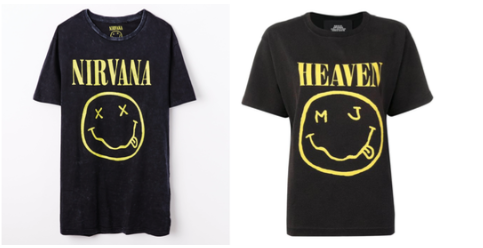In December 2018, Nirvana filed an infringement lawsuit against fashion retailer Marc Jacobs for a shirt known as the “Bootleg Grunge Tee,” as well as a similar sweatshirt and pair of socks, in its then recent line, “The Redux Grunge” collection. More particularly, Nirvana alleged copyright infringement, false designation of origin, trademark infringement, and unfair competition. In this way, Nirvana seeks to demonstrate that they are not associated with, nor do they endorse Marc Jacobs. Further, Nirvana does not want the Marc Jacobs design to confuse consumers into believing otherwise. Nirvana also included Saks Fifth Avenue and Neiman Marcus as co-defendants due to their carrying of the Bootleg Grunge Tee.
Copyright, patent, and trademark laws exist in order to protect the creators of intellectual property as well as the consumers thereof. A trademarkis a word, phrase, symbol, and/or design that identifies and distinguishes the source of the goods of one party from those of others. A trademark is aimed at protecting the consumer by allowing them to know the exact source of certain goods or services. Trademark infringement occurs when there exists the likelihood of confusing one product or service with another.
Copyright, on the other hand, protects original works of authorship and is therefore aimed at protecting creators by allowing them to profit from their original works. To prove copyright infringement, the copyright holder must show that the copying party had access to the original work and that the two works are substantially similar. Similarly, unfair competition takes place when there is an attempt to replace a product or service that already exists with the intention of deceiving the public.
In this lawsuit, Nirvana claims that a Marc Jacobs shirt unlawfully copied a design created by the late Kurt Cobain in 1991. The design in question is an iconic design associated with Nirvana, consisting of a yellow happy face against a black background with an “X” in the place of each eye, a squiggly upward facing smile, and a small tongue sticking out to the right. In Nirvana’s most common use of the design, they include “NIRVANA” printed in all capital letters also in yellow above the happy face design. The allegedly infringing Marc Jacobs shirt includes the same happy face with tongue design, but instead with an “M” and a “J” for eyes and the word “HEAVEN” appearing in yellow capital letters and a similar font to that of Nirvana’s design above the happy face. It is important to note that Nirvana has been using this happy face design to identify their music since 1992 and have used the design on all of its merchandise, including short sleeved shirts similar to the one distributed by Marc Jacobs.
In
the case’s most recent development, U.S. District Judge John A. Kronstadt heard
and decided Marc Jacobs’ motion to dismiss. In its motion, Marc Jacobs
primarily argues that Nirvana does not possess a monopoly on the smiley face
design by itself but rather, that its copyright registration covers additional
elements, including “NIRVANA” above the face and the words “flower sniffin kitty pettin baby kissin corporate rock
whores” on the back of the t-shirt. Marc Jacobs further claims that to the
extent Nirvana’s copyright covers the smiley face design, it is a different one
than that found on the fashion designer’s t-shirts, sweatshirts, and socks.
Moreover, by replacing the smiley face’s crosses
for eyes with the letters “M” and “J,” and the word “NIRVANA” with “HEAVEN,” Marc
Jacobs argues that the design is not an exact replica of Nirvana’s well-known
design and therefore does not infringe the copyright.
Marc Jacobs’ other primary argument in its motion to dismiss centered around how Nirvana’s complaint allegedly contains no explanation of how Kurt Cobain, as original author for Nirvana’s smiley face, transferred his ownership rights to Nirvana. Only the legal or beneficial owner of an exclusive right under a copyright is entitled to institute an action for infringement. Additionally, Marc Jacobs argues that the publication date on Nirvana’s copyright application is false and therefore, their registration is invalid. The presumption of copyright validity may be rebutted in this way if Marc Jacobs could sufficiently show that Nirvana knew the publication date was inaccurate and this inaccuracy would have caused the Copyright Office to refuse the registration.
Motions to dismiss are granted when the complaint lacks a cognizable legal theory or sufficient facts to support one. If granted, the claims upon which it is based are dismissed from the case. If denied, the case proceeds forward, potentially to trial. Here, Marc Jacobs, Saks, and Neiman Marcus attempted to dismiss all claims against them. In denying the motion to dismiss, the judge found Marc Jacobs’ arguments unpersuasive. For one, the judge determined that Nirvana sufficiently alleged the similarities between Marc Jacobs’ t-shirt design and the copyrighted design by including various images of the two designs and listing multiple similar features. The court also found that Nirvana had sufficiently alleged ownership because the copyright registration lists Nirvana as its initial author. Finally, regarding Marc Jacobs’ assertion that the date of publication of the copyrighted design is inaccurate, the judge determined that Marc Jacobs failed to show that the date is indeed inaccurate and further that the plaintiffs knew of any such inaccuracy. Thus, Marc Jacobs’ motion to dismiss was denied, which causes the case to proceed.

